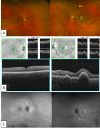Rapidly Progressive Bilateral Vitreoretinal Lymphoma
- PMID: 36540473
- PMCID: PMC9757659
- DOI: 10.7759/cureus.31639
Rapidly Progressive Bilateral Vitreoretinal Lymphoma
Abstract
A 56-year-old male who presented with unilateral localized sub-retinal lesions suspicious for primary vitreoretinal lymphoma (PVRL) developed florid bilateral ocular involvement and was found to have lesions on MRI of the brain in a five-week period despite the absence of vitreous involvement during the entire course of his disease. His ocular lesions were monitored while on systemic treatment and an excellent clinical response was achieved. His central nervous system (CNS) lesions, however, continued to progress despite chemotherapy and whole-brain radiation. He died 12 months from his time of ocular diagnosis. To our knowledge, this case represents the most rapid progression of PVRL reported in the literature - from unilateral, localized lesions in the sub-retinal space to bilateral ocular involvement and identification of CNS involvement in a five-week period. This case highlights the potential for rapid ocular progression of PVRL stressing the need for early diagnosis. Therefore, we recommend prompt vitreous and, if necessary, sub-retinal biopsy in cases of suspected vitreoretinal lymphoma in addition to neuro-imaging. We emphasize the importance of coordination between pathologists, ophthalmologists, and oncologists for prompt, accurate diagnosis. Delay in diagnosis and treatment can result in rapid intraocular progression and central nervous system spread.
Keywords: central nervous system lymphoma; ocular lymphoma; primary vitreoretinal lymphoma; rapid progression lymphoma; vitreoretinal surgery.
Copyright © 2022, Fong et al.
Conflict of interest statement
The authors have declared that no competing interests exist.
Figures





References
-
- Clinical features, laboratory investigations, and survival in ocular reticulum cell sarcoma. Freeman LN, Schachat AP, Knox DL, Michels RG, Green WR. Ophthalmology. 1987;94:1631–1639. - PubMed
-
- Primary intraocular lymphoma (ocular reticulum cell sarcoma) diagnosis and management. Char DH, Ljung BM, Miller T, Phillips T. Ophthalmology. 1988;95:625–630. - PubMed
Publication types
LinkOut - more resources
Full Text Sources
